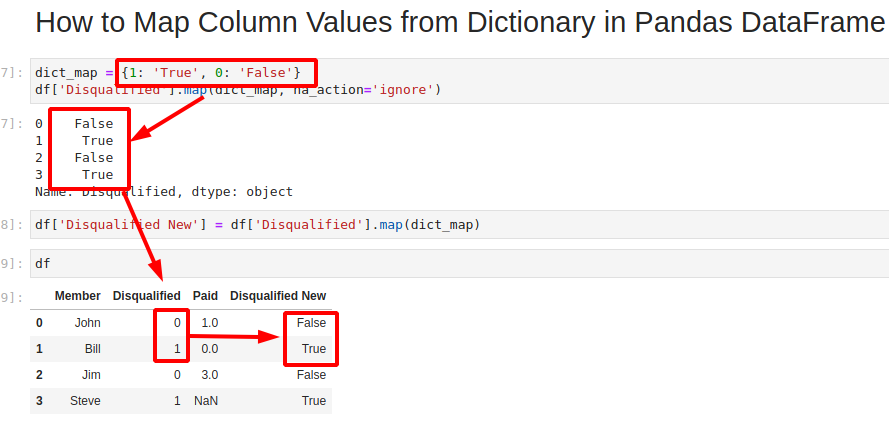1. Overview
In this tutorial, we'll learn how to map column with dictionary in Pandas DataFrame. We are going to use Pandas method pandas.Series.map which is described as:
Map values of Series according to an input mapping or function.
There are several different scenarios and considerations:
- remap values in the same column
- add new column with mapped values from another column
- not found action
- keep existing values
Let's cover all examples in the next sections. The image below illustrates how to map column values work:

2. Setup
In the post, we'll use the following DataFrame, which consists of several rows and columns:
import pandas as pd
import numpy as np
data = {'Member': {0: 'John', 1: 'Bill', 2: 'Jim', 3: 'Steve'},
'Disqualified': {0: 0, 1: 1, 2: 0, 3: 1},
'Paid': {0: 1, 1: 0, 2: 0, 3: np.nan}}
df = pd.DataFrame(data)
Data looks like:
| Member | Disqualified | Paid | |
|---|---|---|---|
| 0 | John | 0 | 1.0 |
| 1 | Bill | 1 | 0.0 |
| 2 | Jim | 0 | 0.0 |
| 3 | Steve | 1 | NaN |
3. Pandas map Column with Dictionary
First let's start with the most simple case - map values of column with dictionary.
We are going to use method - pandas.Series.map.
We are going to map column Disqualified to boolean values - 1 will be mapped as True and 0 will be mapped as False:
dict_map = {1: 'True', 0: 'False'}
df['Disqualified'].map(dict_map)
The result is a new Pandas Series with the mapped values:
0 False
1 True
2 False
3 True
Name: Disqualified, dtype: object
3.1 Map column values in DataFrame
We can assign this result Series to the same column by:
df['Disqualified'] = df['Disqualified'].map(dict_map)
3.2 Map dictionary to new column in Pandas
To map dictionary from existing column to new column we need to change column name:
df['Disqualified Boolean'] = df['Disqualified'].map(dict_map)
In case of a different DataFrame be sure that indices match
4. Mapping column values and preserve values(NaN)
What will happen if a value is not present in the mapping dictionary? In this case we will end with NA value:
df['Paid'].map(dict_map )
result:
0 True
1 False
2 NaN
3 NaN
Name: Paid, dtype: object
In order to keep the not mapped values in the result Series we need to fill all missing values with the values from the column:
df['Paid'].map(dict_map).fillna(df['Paid'])
This will result into:
0 True
1 False
2 3.0
3 NaN
Name: Paid, dtype: object
To keep NaNs we can add parameter - na_action='ignore':
df['Disqualified'].map(dict_map, na_action='ignore')
5. Map Column in Pandas - map() vs replace()
An alternative solution to map column to dict is by using the function pandas.Series.replace.
The syntax is similar but the result is a bit different:
df["Paid"].replace(dict_map)
In the result Series the original values of the column will be present:
0 True
1 False
2 3.0
3 NaN
Name: Paid, dtype: object
Another difference between functions map() and replace() are the parameters:
.replace(dict_map, inplace=True)- applying changes on the Series itself- `df['Paid'].map(dict_map, na_action='ignore') - to avoid applying the function to missing values (and keep them as NaN)
Finally we can mention that replace() can be much slower in some cases.
6. Map column with s.update() in Pandas
Another option to map values of a column based on a dictionary values is by using method s.update() - pandas.Series.update
This can be done by:
df['Paid'].update(pd.Series(dict_map))
The result will be update on the existing values in the column:
0 False
1 True
2 3.0
3 NaN
Name: Paid, dtype: object
The function is described as:
Modify Series in place using values from passed Series.
Uses non-NA values from passed Series to make updates. Aligns on index
7. Map dictionary to new column in Pandas DataFrame
Finally we can use pd.Series() of Pandas to map dict to new column. The difference is that we are going to use the index as keys for the dict:
df["Disqualified mapped"] = pd.Series(dict_map)
To use a given column as a mapping we can use it as an index. Then we an create the mapping by:
df = df.set_index(['Disqualified'])
df['Disqualified mapped'] = pd.Series(dict_map)
8. Conclusion
In this tutorial, we saw several options to map, replace, update and add new columns based on a dictionary in Pandas.
We first looked into using the best option map() method, then how to keep not mapped values and NaNs, update(), replace() and finally by using the indexes.









